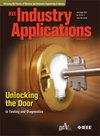部分电源变换器电力系统接地故障诊断方法
IF 4.5
2区 工程技术
Q2 ENGINEERING, ELECTRICAL & ELECTRONIC
引用次数: 0
摘要
部分电源转换器(PPCs)已被证明是高效,高密度的解决方案,可以减少电气压力。然而,由于PPCs不够成熟,仍然需要对其可靠性进行广泛的分析。尽管它们有能力改变端子之间的电压水平,类似于电力变压器,但它们不能在两端之间提供电流隔离。然后,在发生接地故障的情况下,整个系统变得高度暴露。因此,本文提出了一种基于ppc的接地故障检测方法。该方法依赖于一个接地电阻,该电阻依次连接在直流系统的正、负和中点端子之间,通过三个不同的开关接地。本文提供了一个详细的解释的方法和必要的组成部分,以执行诊断。本文介绍了在MATLAB-Simulink中进行的仿真设置,并给出了仿真结果。然后,在健康和故障情况下,使用50kw输入-串联-输出-并联PPC试验台来验证该方法。结果表明,该方法不仅可以检测到接地故障,而且可以识别出接地故障的位置,减少了维护工作。本文章由计算机程序翻译,如有差异,请以英文原文为准。
Ground Fault Diagnosis Method for Partial Power Converter-Based Electric Systems
Partial power converters (PPCs) have proven to be efficient, high-density solutions that reduce electrical stress. However, due to their lack of maturity, PPCs still require an extensive analysis of their reliability. Despite their capability of varying the voltage level between its terminals, similarly to a power transformer, they cannot provide galvanic isolation between both sides. Then, in the event of a ground fault, the entire system becomes highly exposed. Therefore, this paper presents a ground fault detection method for PPC-based solutions. The approach relies on a grounding resistor that is sequentially linked between the positive, negative, and midpoint terminals of the DC systems, grounded by three different switches. The paper provides a detailed explanation of the methodology and the necessary components to perform the diagnosis. A simulation setup conducted in MATLAB-Simulink is presented, along with its results. Afterwards, an experimental 50-kW Input-Series-Output-Parallel PPC test bench is used under both healthy and faulty scenarios to validate the methodology. The results conclude that this method not only detects the ground faults, but it also discerns its location, reducing the maintenance work.
求助全文
通过发布文献求助,成功后即可免费获取论文全文。
去求助
来源期刊

IEEE Transactions on Industry Applications
工程技术-工程:电子与电气
CiteScore
9.90
自引率
9.10%
发文量
747
审稿时长
3.3 months
期刊介绍:
The scope of the IEEE Transactions on Industry Applications includes all scope items of the IEEE Industry Applications Society, that is, the advancement of the theory and practice of electrical and electronic engineering in the development, design, manufacture, and application of electrical systems, apparatus, devices, and controls to the processes and equipment of industry and commerce; the promotion of safe, reliable, and economic installations; industry leadership in energy conservation and environmental, health, and safety issues; the creation of voluntary engineering standards and recommended practices; and the professional development of its membership.
 求助内容:
求助内容: 应助结果提醒方式:
应助结果提醒方式:


